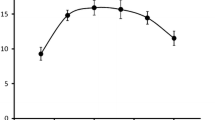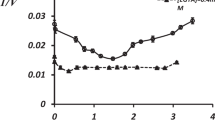Summary
-
1.
The effects of ATP and inorganic phosphate (Pi) on the reactivation of glutamate apodecarboxylase by its cofactor pyridoxal-5′-phosphate (pyridoxal-P) was studied. Apoenzyme was prepared by preincubation with glutamate.
-
2.
Apoenzyme prepared with glutamate alone was reactivated slowly and incompletely by adding a saturating concentration of pyridoxal-P (20µM). Reactivation was slightly enhanced by 1–10 mM Pi.
-
3.
Reactivation by pyridoxal-P plus Pi was greatly enhanced by the presence of low concentrations (<100µM) of ATP during the preparation of apoenzyme with glutamate. Reactivation was much lower if Pi was omitted.
-
4.
Enhancement of reactivation by ATP was due to its effect during apoenzyme formation, since ATP did not enhance reactivation if added only during reactivation and since the enhancing effect persisted after the removal of free ATP by chromatography on Sephadex G-25 after apoenzyme preparation and before reactivation.
-
5.
Reactivation was inhibited by high concentrations of ATP (>100µM), possibly by competition of ATP for the cofactor binding site.
-
6.
Four factors (glutamate, pyridoxal-P, ATP, and Pi) control a cycle of inactivation and reactivation that appears to be important in the regulation of brain glutamate decarboxylase.
Similar content being viewed by others
References
Blindermann, J. -M., Maitre, M., Ossola, L., and Mandel, P. (1978). Purification and some properties of L-glutamate decarboxylase from human brain.Eur. J. Biochem. 86143–152.
Fonda, M. L. (1975). The effect of anions on the interaction of pyridoxal phosphate with glutamate apodecarboxylase.Arch. Biochem. Biophys. 170690–697.
Hathaway, J. A., and Atkinson, D. E. (1963). The effect of adenylic acid on yeast nicotinamide adenine dinucleotide isocitrate dehydrogenase, a possible metabolic control mechanism.J. Biol. Chem. 2382875–2881.
Hawkins, R. A., Nielsen, R. C., and Veech, R. L. (1973). The measurement of the inorganic phosphate content of brain in the presence of bone fragments.J. Neurochem. 2035–38.
Kimelberg, H. K., and Bourke, R. S. (1982). Anion transport in the nervous system. InHandbook of Neurochemistry, 2nd ed. (Lajtha, A., Ed.), Vol. 1, pp. 31–64.
Martin, S. B., and Martin, D. L. (1979). Stimulation by phosphate of the activation of glutamate decarboxylase by pyridoxal-5′-phosphate and its implications for the control of GABA synthesis.J. Neurochem. 331275–1283.
Martin, D. L., and Martin, S. B. (1982). Effect of nucleotides and other inhibitors on the inactivation of glutamate decarboxylase.J. Neurochem. 391001–1008.
Martin, D. L., Meeley, M. P., Martin, S. B., and Pedersen, S. (1980). Factors influencing the activation and inactivation of glutamate decarboxylase.Brain Res. Bull. 5 (Suppl. 2):57–61.
Matsuda, T., Wu, J. -Y., and Roberts, E. (1973). Sodium dodecyl sulfate acrylamide gel electrophoresis of glutamic acid decarboxylase from mouse brain.J. Neurochem. 21167–172.
Meeley, M. P., and Martin, D. L. (1983). Inactivation of brain glutamate decarboxylase and the effects of adenosine 5′-triphosphate and inorganic phosphate.Cell. Mol. Neurobiol. 339–54.
Miller, L. P., and Walters, J. R. (1978). Effect of depolarization on cofactor regulation of glutamic acid decarboxylase insubstantia nigra synaptosomes.J. Neurochem. 33533–539.
Miller, L. P., Walters, J. R., and Martin, D. L. (1977). Postmortem changes implicate adenine nucleotides and pyridoxal-5′-phosphate in the regulation of brain glutamate decarboxylase.Nature 266847–848.
Miller, L. P., Walters, J. R., Eng, N., and Martin, D. L. (1980). Glutamate holodecarboxylase levels and the regulation of GABA synthesis.Brain Res. Bull. 5 (Suppl. 2):89–94.
O'Leary, M. H., and Malik, J. M. (1972). Kinetics and mechanisms of the binding of pyridoxal-5′-phosphate to apoglutamate decarboxylase. Evidence for a rate determining conformational change.J. Biol. Chem. 2477097–7105.
Ryan, L. D., and Roskowski, R. (1976). Resolution and reconstitution of glutamate decarboxylase from cerebellum.Neurochem. Res. 137–45.
Seligmann, B., Miller, L. P., Brockman, D. E., and Martin, D. L. (1978). Studies on the regulation of GABA synthesis: The interaction of adenine nucleotides and glutamate with brain glutamate decarboxylase.J. Neurochem. 30371–376.
Seydoux, F., Malhotra, O. P., and Bernhard, S. A. (1974). Half-site reactivity.CRC Crit. Rev. Biochem. 2227–257.
Tursky, T. (1970). Inhibition of brain glutamate decarboxylase by adenosine triphosphate.Eur. J. Biochem. 12544–549.
Veech, R. L., Harris, R. L., Veloso, D., and Veech, E. H. (1973). Freeze-blowing: A new technique for the study of brainin vivo.J. Neurochem. 20183–188.
Author information
Authors and Affiliations
Rights and permissions
About this article
Cite this article
Meeley, M.P., Martin, D.L. Reactivation of substrate-inactivated brain glutamate decarboxylase. Cell Mol Neurobiol 3, 55–68 (1983). https://doi.org/10.1007/BF00734998
Received:
Accepted:
Issue Date:
DOI: https://doi.org/10.1007/BF00734998




